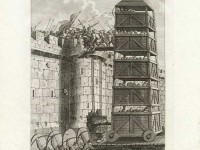Siege towers were used to overcome high walls and to put their own soldiers on the battlements. The first siege towers were already used in antiquity in the storming of fortified towns. In most cases, the towers were made of a wooden structure with several floors. Due to the logistical effort, the material for the construction was cut from the surrounding forest of the besieged city or castle and the tower was built before the eyes of the enemy. The dimensions were, depending on the height of the wall, usually around 5m to 15m side length and up to 40m high.
Attack with a siege tower:
Depending on the design of the tower, the uppermost level was designed for the archers or for the assaulters (they were on the penultimate level for archers). The tower was brought to the enemy wall on rollers by the muscle power of humans or animals. In the meantime, the archers covered the soldiers on the battlements with arrows. When the tower was close enough to the wall, a ramp was lowered and the soldiers could storm the battlements. Since only a small group of soldiers could reach the battlements via the tower at any one time, further soldiers either pushed directly through stairs in a queue or the attack was carried out with several towers.
Protective measures against siege towers:
Of course, the defenders were not defenceless against siege towers. Thus they developed different strategies for their defence which could consist of the following measures, among others:
- Construction of a moat
(Through a moat the towers could be kept so far away that they could not get close enough to the wall and could extend their drawbridges for the assault.
- arrows
(By firing arrows, the tower, which in most cases was made of wood, could be set on fire.
- Inserting projectiles
(Catapults could be used to fire heavy projectiles like stones at the tower and cause it to collapse)
- disarm the operating crew
(The advance of the tower could be slowed down or completely interrupted by switching off the operating crew)
- Bring the tower topple / collapse
(Hidden trenches can cause the tower to tip over in motion)
You can find the right literature here:
Siege Warfare Operations Manual: From ancient times to the beginning of the gunpowder age (Haynes Manuals)

Siege Warfare Operations Manual: From ancient times to the beginning of the gunpowder age (Haynes Manuals) Hardcover – May 1, 2018
In contrast to mobile combat, a siege centers around a fixed location, historically ranging from simple hill forts through to entire fortified cities. For the defenders, their job has been to preserve the integrity of defenses, keep out the attackers, and maintain health, hygiene and nutrition until the siege is broken. The attackers, by contrast, have utilized a mixture of guile, patience, technology and brute force to wear down their opponents, smash through the defenses and force submission.
Medieval Sieges & Siegecraft
From Jericho to Troy, medieval Europe knew siege warfare as a tradition of antiquity. Long before the advent of city culture, rivaling civilizations had relied on siege tactics as a means of taking over fortified palaces, temples, and defensive walls. But the dawn of the medieval period brought the “golden age” of siege warfare, as the proliferation of formalized cities made siege tactics the ideal choice from a militaristic standpoint.
In Medieval Sieges & Siegecraft, Geoffrey Hindley looks at the subject from every angle. He traces the development of strong points, castles, and fortified towns and considers the architects and masons who built them; describes the problems of medieval logistics and food supply that confronted both sides during a siege (and which often decided the outcome); and pens vivid portraits of the machinery of warfare—from towers, mines, trebuchets, and mangonels to boiling oil and Greek fire; and considers the parts played by women and camp followers in battle. With the support of fifty illustrations printed throughout the text, Hindley shows siege tactics in action through real-life case studies of famous sieges that changed the course of history in medieval Europe and the Holy Land.
A definitive account of an often overlooked portion of military history, this stimulating and accessible study will be fascinating reading for medieval specialists and for anyone who is interested in the history of warfare.
Skyhorse Publishing, as well as our Arcade imprint, are proud to publish a broad range of books for readers interested in history--books about World War II, the Third Reich, Hitler and his henchmen, the JFK assassination, conspiracies, the American Civil War, the American Revolution, gladiators, Vikings, ancient Rome, medieval times, the old West, and much more. While not every title we publish becomes a New York Times bestseller or a national bestseller, we are committed to books on subjects that are sometimes overlooked and to authors whose work might not otherwise find a home.
LEGO Castle Tower Raid
- Swing the battering ram through the castle's wall to release the captured troll warrior
- Pull the string on the rolling siege tower to extend the bridge to the castle, the rolling siege tower has two flick-fire and 2" wide wheels
- The troll warrior tower is 8" (20cm) tall and 5" (13cm) wide; the castle tower is over 8½" (21cm) tall and 2½" (6cm) wide
- Includes two knights and three troll warrior minifigures with armor and accessories
- Contains 364 pieces
This post is also available in:
 Deutsch (German)
Deutsch (German)  Français (French)
Français (French)  Italiano (Italian)
Italiano (Italian)  简体中文 (Chinese (Simplified))
简体中文 (Chinese (Simplified))  Русский (Russian)
Русский (Russian)  Español (Spanish)
Español (Spanish)  العربية (Arabic)
العربية (Arabic)















